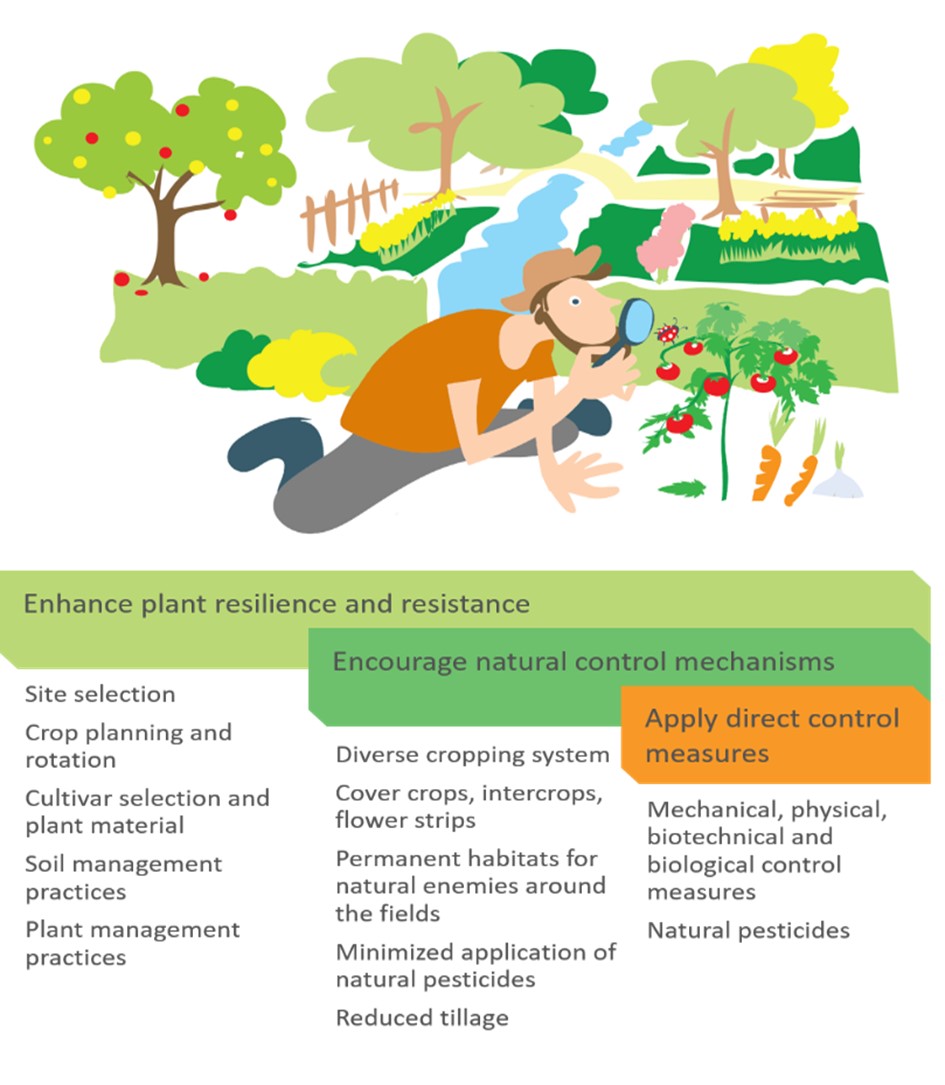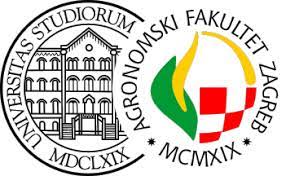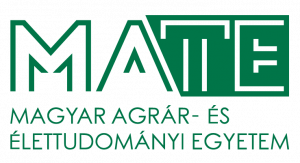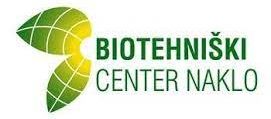2.1 Basic principles of plant protection in organic farming
| Site: | TOPPlant Portal |
| Course: | Training Manual for Plant Protection in Organic Farming |
| Book: | 2.1 Basic principles of plant protection in organic farming |
| Printed by: | Guest user |
| Date: | Wednesday, 10 December 2025, 4:14 PM |
Table of contents
- 2.1 Basic principles of plant protection in organic farming
- 2.1.1 Providing good growing conditions for plants to enhance their resilience and resistance
- 2.1.2 Encouraging natural control mechanisms of the ecosystem through promotion of natural enemies
- 2.1.3 Application of direct control measures to kill the pests, diseases or weeds in a way that has minimum residual effect to the ecosystem
Basic principles of plant protection in organic farming
Learning Outcomes:
- Define the main differences in plant protection between conventional and organic farming.
- Explain the three-step approach to pest, disease and weed management in organic farming.
- State the EU regulation on plant protection products used in organic farming.
Crop protection from diseases, pests and weeds is the most demanding segment of organic farming. Due to the holistic approach, it requires a lot of producers’ knowledge and experience for planning the production and implementation of all technological measures and their impact on the development of certain groups of harmful organisms. The fear that adhering to the guidelines for organic cultivation, where we cannot rely on effective plant protection products available in conventional production, it will not be possible to preserve crops from pests, is often the main reason why growers find it difficult to switch to organic production.
However, organic protection is not correctly perceived as an alteration of the plant protection products, from those that are effective to those that are less effective. It implies changing the entire production system and introducing some new measures that will make our farm, crops and individual plants more resistant to pest attack. Organic protection primarily relies on preventive measures and careful monitoring of conditions for the development of harmful organisms and their populations, and only in conditions when the threshold of economic damage is exceeded, direct measures are implemented, including the use of permitted plant protection products.
The problem of pest management is particularly pronounced in the period of conversion of the farm when self-regulation of the ecosystem is underdeveloped, and producers are inexperienced. Therefore, before the transition, it is necessary to make a detailed plan of conversion that in each segment of production considers its impact on the development of pests. Plant protection in organic production relies on the three-step approach (Figure 2.1).
Providing good growing conditions for plants to enhance their resilience and resistance
By choosing the appropriate location, production system, variety and technology, it is required to create favourable conditions for the development of healthy and resistant plants, and unfavourable conditions for the development of diseases, pests and weeds. Different agricultural crops, and especially annual and perennial species, have specific growing demands and technological solutions need to be adapted to them, but the principles we are guided by are common. Proper site selection should provide adequate lighting, airing and drainage, while one near potential sources of infection needs to be avoided. The possibility of damage and economic losses will be reduced by growing varieties resistant to the main pests. Planting and sowing healthy reproductive material will prevent the entry of the infection source. The appropriate system of soil maintenance and balanced organic fertilization will improve soil fertility and increase the diversity of soil microorganisms. Plants grown on fertile soil will be more resistant, and among the diverse microbiological population, natural enemies of soil pests will develop as well. By organizing crop rotation and growing several crops in the same field, the accumulation of harmful organisms will be avoided. Selection of the appropriate plant spacing and plant management in the field create an unfavourable microclimate for the development of diseases and weeds, while the monitoring of infection symptoms, pest populations and the application of plant protection products are facilitated.
When establishing an agricultural holding and carrying out technological interventions, it should be always kept in mind that all the implemented measures have an important impact on the development of diseases, population of pests and weeds in the field. By implementing them properly, the problem of important pests of the crops can be permanently reduced.

Encouraging natural control mechanisms of the ecosystem through promotion of natural enemies
One of the main characteristics of natural ecosystems is the ability of self-regulation. These ecosystems exist completely without external influence and they provide a natural circulation of nutrients that allow the development of plants that serve as a source of food for various animals, insects and microorganisms. Species that live within the same habitat are in different interrelations where they have the roles of predators, parasitoids, prey, decomposers. Their relationships enable the self-regulation of ecosystems, which does not allow the population of one species increases so much that the sustainability of other species is disputed.
Modern agricultural production in which we often grow endless fields of the same culture, choose vigorous and yielding varieties, intensively fertilize with mineral fertilizers, and regulate the population of harmful organisms with effective plant protection products is completely contrary to the conditions of natural ecosystems. Various technological interventions eliminate all organisms from the "ecosystem" beside the culture we grow, both harmful and beneficial. In such circumstances, cultivated plants are very susceptible to pest attacks that have an inexhaustible source of food, and as we have removed all their natural enemies, their population can grow to the point of destroying the entire crop. Such production systems are completely unsustainable without the constant influence of man and the introduction of various inputs outside the farm.
Therefore, in organic farming, one of the main goals is to encourage the diversity of species in and around fields, and to create habitats attractive to natural enemies that will help to regulate pests. Moreover, it is desirable that organic farms are of a mixed type in order to avoid large areas under the same crop, and it is recommended that livestock farming is developed in addition to crop production.
Species diversity is encouraged by organizing different ecological infrastructures suitable for individual crops. Permanent habitats around fields, such as meadows, rocky areas, forests, lakes, etc., hedges and dry-stone walls along the edge of a field, flower strips and cover crops in vineyards and orchards serve as ecological infrastructure. Ecological infrastructure should provide food to natural enemies as well as shelter while there are no crops. Tall vegetation around the fields also serves as a barrier against the introduction of pests from the outside, prevents the drift of plant protection products, reduces wind gusts, etc. In addition, cover cropping has a positive effect on soil fertility, storage of water in the soil, while it prevents erosion and the harmful effects of direct sunlight and precipitation on bare soil. The choice of infrastructure needs to be adapted to the culture we grow to prevent potential negative impacts. The habitat of beneficial organisms can also be a habitat for pests or viral vectors where some plant species are alternative hosts to diseases of agricultural crops. Moreover, a competitive relationship for water and nutrients with cultivated plants should be avoided, as well as shading of the agricultural area.
Application of direct control measures to kill the pests, diseases or weeds in a way that has minimum residual effect to the ecosystem
Direct measures to control diseases and pests are used if preventive measures did not give a satisfactory result. To decide if suppression is needed and to set time limits, it is necessary to establish a system of monitoring environmental conditions for forecasting the development of diseases and pests, monitoring the population of pests and their natural enemies, the appearance of disease symptoms and knowing the thresholds of economic damage. For successful monitoring, it is necessary to be familiar with the biology of pests and the symptoms they cause on plants. Direct measures aim to reduce the population below the critical number with as little negative impact on the ecosystem as possible. These include physical measures (collection of insects, weeding, burning, hoeing, mowing, tillage) and the use of products of different origins that enhance the resistance of plants and ecosystems, while they act to the environment, natural enemies and other organisms with a low risk. Botanical pesticides, biopesticides, pheromones, mineral-based preparations, etc., are the most used products, whose application is permitted by regulations on organic farming.
Protection against diseases and pests in organic farming defined by Regulation (EU) 834/2007, which will be replaced by Regulation (EU) 848/2018 of the European Parliament and of the Council on the 1st of January 2022. In addition to the basic principles of pest protection, which relies primarily on the previously described preventive measures, the regulation also controls the approval of products and active substances used in plant protection products.
Products whose use is crucial for the control of a harmful organism for which there are no alternative biological, physical or growing solutions, cultivating practices or other effective management procedures are approved to use. These products and substances originate from plants, algae, animals, microbes or minerals. Exceptionally, other products may be approved if their use is crucial for the control of a harmful organism for which there are no alternative biological, physical or growing solutions, growing practices or other effective management procedures. When using such products, the required waiting periods must be kept after contact with edible parts of the crop. Plant protection products used in organic farming must be registered or permitted in accordance with the abovementioned regulation.





